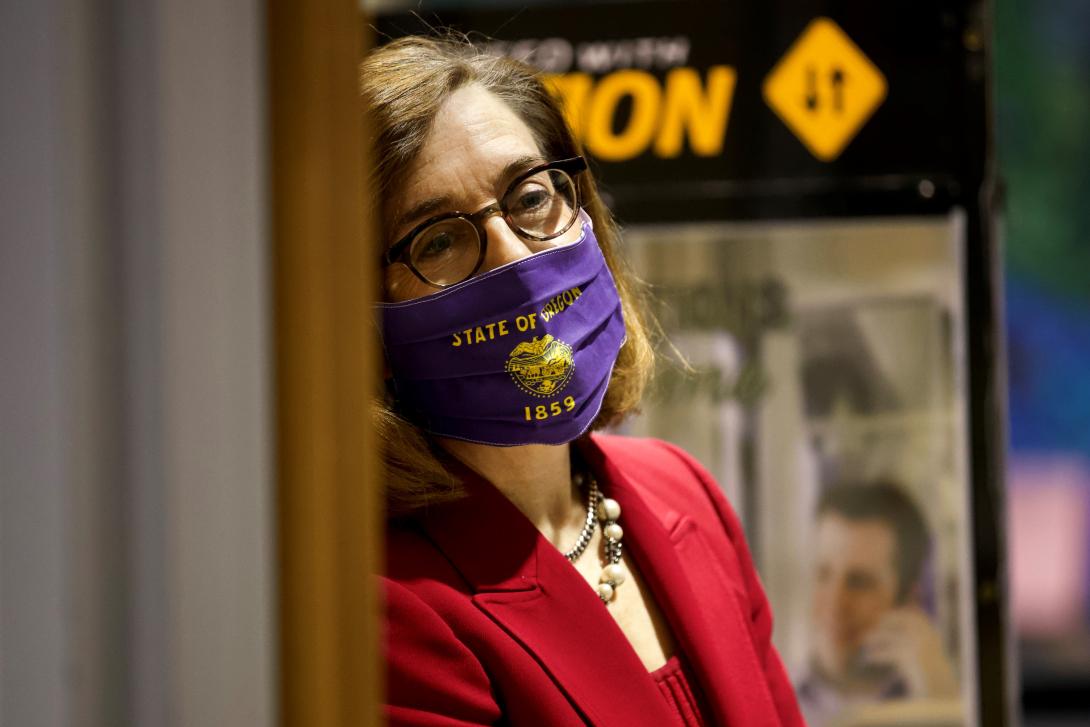
With COVID-19 cases and deaths rising in Oregon, Gov. Kate Brown announced Wednesday new restrictions designed to prevent the disease from overwhelming parts of the state.
The state is adopting new face mask requirements and restricting large gatherings in indoor public places.
Face masks will be required at gyms -- even while exercising -- and parents will have to ensure that their children aged 5 and older in indoor public spaces and outdoors where it’s impossible to stay 6 feet apart have their face covered. Gatherings in indoor venues such as larger restaurants, bars, community centers, houses of worship and gyms in Phase 2 counties will be restricted to a maximum of 100 people compared with 250 now; and bars and restaurants in Phase 1 and Phase 2 will have to close at 10 p.m. instead of midnight.
The restrictions will go into effect on Friday and will apply to the entire state. Multnomah, Washington and Clackamas counties will remain in Phase 1.
The rollback marks the state’s response to increased infections, she said at a news conference.
“We ventured out onto the ice together, and that ice has begun to crack,” Brown said. “Before we fall through the ice, we need to take additional steps to protect ourselves and our communities.”
The announcement comes amid 2,400 new infections in Oregon over the past week, according to Oregon Health Authority figures. That marked a 26% increase from the week before. Deaths have gone up, too, with 25 reported last week compared with 22 the week before.
And on Wednesday, the health authority reported 264 new cases and two new deaths.
In earlier months, many of the cases stemmed from workplaces, senior care centers and other places where people either live together or spend long periods of time together. Those cases have diminished, said Dr. Dean Sidelinger, state epidemiologist.
In response to that, the state is allowing outdoor visiting at senior care facilities that do not have infections.
But while the disease appears to be subsiding at care centers, a new pattern has emerged that is more difficult for health officials to fight.
“Our sporadic cases are growing,” Sidelinger said. “These are people who became infected with COVID-19, and we don’t know where they got it. This is evidence of community spread.”
As of last week, he said, about half of the new cases in Oregon could not be traced to a known source, indicating that the virus is more rampant than feared. This week Oregon surpassed the 15,000 case count, with more than 270 deaths.
State and local health authorities rely on so-called contact tracers to stem further infections. They reach out to people who’ve been in contact with someone newly infected to warn them that they may have been infected as well, with the hope that those people self-isolate for 14 days to blunt the spread of the virus.
The state set a goal of tracing 95% of new cases within 24 hours. But it’s fallen below that, Sidelinger said, hitting 93%.
“Our contact tracing capacity is under strain,” Sidelinger said.
State health officials did not immediately respond to a request for more details.
The state also has a problem with tests, which are in high demand around the country. Manufacturers are delivering them more slowly than the state would like, according to the Oregon Health Authority. Also, many people are having to wait days to get their test results. That, too, hinders public efforts to prevent the spread of the disease.
Sidelinger said the restrictions announced by Brown -- especially the limit of large gatherings to 100 people -- aim to stop so-called super spreader events where one person who might not even know they have the virus infects others in a group gathering and then those people also unknowingly infect others.
“We’re concerned about some of our rural and Eastern Oregon counties that have our highest rates of cases of community spread right now,” Sidelinger said.
(See our related story: Hard Hit Rural Oregon Counties Getting ‘Overwhelmed’ By Virus)
Some of the new cases stem from visitors from out-of-state, Brown said.
She said officials in her office are in talks with Oregon’s neighbors to possibly restrict travel from heavily infected areas.
“The focus will be on tourists coming from hotspots in other parts of the country,” Brown said.
She indicated that truckers would not be affected or people who have to cross state lines to work.
“We know that it’s critically important to keep supply chains intact,” Brown said. “We don’t want to restrict travel for employment purposes for work.”
She also repeated that the upcoming school year in Oregon will be unlike any other and will include the requirement that children aged 5 and older wear face coverings.
Studies indicate that children aged 10 and older spread the disease as easily as adults but younger children do not and they’re less likely to develop symptoms. Still, they’re in families are are cared for by older people, including grandparents, who could be at risk of developing serious complications, Sidelinger said.
You can reach Lynne Terry at [email protected].